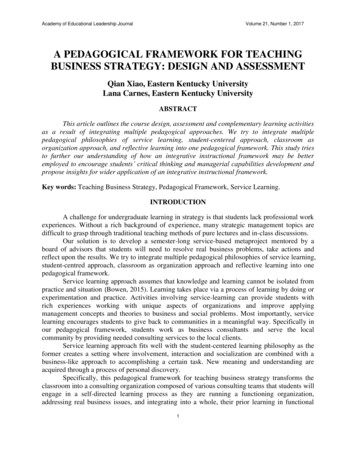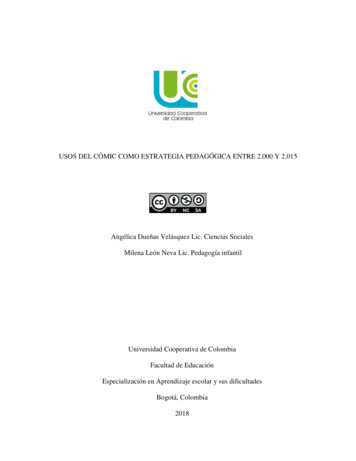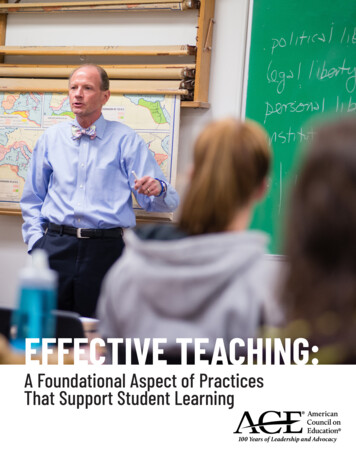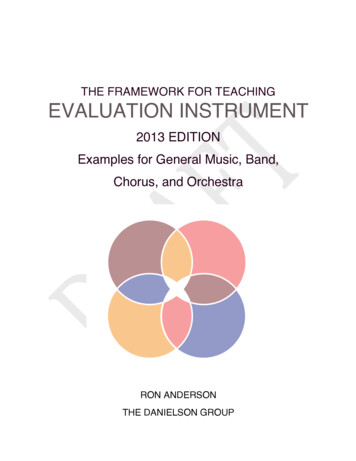
Transcription
Academy of Educational Leadership JournalVolume 21, Number 1, 2017A PEDAGOGICAL FRAMEWORK FOR TEACHINGBUSINESS STRATEGY: DESIGN AND ASSESSMENTQian Xiao, Eastern Kentucky UniversityLana Carnes, Eastern Kentucky UniversityABSTRACTThis article outlines the course design, assessment and complementary learning activitiesas a result of integrating multiple pedagogical approaches. We try to integrate multiplepedagogical philosophies of service learning, student-centered approach, classroom asorganization approach, and reflective learning into one pedagogical framework. This study triesto further our understanding of how an integrative instructional framework may be betteremployed to encourage students’ critical thinking and managerial capabilities development andpropose insights for wider application of an integrative instructional framework.Key words: Teaching Business Strategy, Pedagogical Framework, Service Learning.INTRODUCTIONA challenge for undergraduate learning in strategy is that students lack professional workexperiences. Without a rich background of experience, many strategic management topics aredifficult to grasp through traditional teaching methods of pure lectures and in-class discussions.Our solution is to develop a semester-long service-based metaproject mentored by aboard of advisors that students will need to resolve real business problems, take actions andreflect upon the results. We try to integrate multiple pedagogical philosophies of service learning,student-centred approach, classroom as organization approach and reflective learning into onepedagogical framework.Service learning approach assumes that knowledge and learning cannot be isolated frompractice and situation (Bowen, 2015). Learning takes place via a process of learning by doing orexperimentation and practice. Activities involving service-learning can provide students withrich experiences working with unique aspects of organizations and improve applyingmanagement concepts and theories to business and social problems. Most importantly, servicelearning encourages students to give back to communities in a meaningful way. Specifically inour pedagogical framework, students work as business consultants and serve the localcommunity by providing needed consulting services to the local clients.Service learning approach fits well with the student-centered learning philosophy as theformer creates a setting where involvement, interaction and socialization are combined with abusiness-like approach to accomplishing a certain task. New meaning and understanding areacquired through a process of personal discovery.Specifically, this pedagogical framework for teaching business strategy transforms theclassroom into a consulting organization composed of various consulting teams that students willengage in a self-directed learning process as they are running a functioning organization,addressing real business issues, and integrating into a whole, their prior learning in functional1
Academy of Educational Leadership JournalVolume 21, Number 1, 2017business courses (marketing, finance, accounting, management, operations and informationsystems).In the end of the project, students will wrap up through writing a reflective paper toexpress their thoughts, feelings and experiences toward the learning content and processes. Thepractice of reflective thinking offers a key to a deeper sense of learning and experience andreinforces the learning process with students exploring their personal engagement with academicsubject content, the individual learning processes and practical applications of those subjectmatters in a consulting service context.We truly believe that our designed semester-long service-based metaproject couldfunction as an effective platform that integrates the above learning/teaching philosophies withina pedagogical framework. This pedagogical framework brings together the management theories,real world practice and personal reflection, challenges students to tackle real world businessissues, and as a result enhances students’ managerial capabilities (Marquardt & Yeo, 2012). Thepurpose of this article is to describe how we integrate multiple pedagogical philosophies in ameaningful way to create unique learning experience for students and enhance their learningwith students experiencing the unstructured problems that actual organizations face, engaging ina real problem solving process and practicing skills and knowledge to help communityorganizations. The article outlines the course design, assessment and complementary learningactivities as a result of integrating multiple pedagogical approaches. This study tries to furtherour understanding of how an integrative instructional framework may be better employed toencourage students’ critical thinking and managerial capabilities development and proposeinsights for wider application of an integrative instructional framework.Course Overview and Learning ObjectivesUnder the umbrella of the business strategy capstone course we will create student-runconsulting companies that provide consulting services to small businesses in the local regions.GBU480 (Business Strategy) classes will participate in the project. GBU480 is a 15 weekscapstone and applied critical creative thinking course, where students need to demonstrate allthat has been learned in his or her major.Our plan is to create a real business problem-based hands-on encounter where students will beable to run a functioning organization, address real business issues and integrate into a whole,their prior learning in functional business courses (marketing, finance, accounting, management,operations and information systems). Such integrative and pedagogical framework will lead to aculminating learning experience for deeper understanding of the discipline, and fits well with thecourse requirements of GBU480. Specifically, students will organize as consulting companies toeither partner with local clients from Small Business Development Centre (SBDC) of theuniversity or go out to seek for their own local clients, and provide consulting services to helpthem address issues of business growth and development. This teaching approach through theaction learning based project provides a rich context where learning takes place through concreteactions, reflections on experience, and a process of resolving problems and identifyingopportunities for real organizations, not simulations. The direct benefits would be that “learningby doing” offers a great educational experience for students; and this brings the campus andcommunity together. Specifically, expected objectives include: first, by creating a realorganization to do the consulting and engage in the real business operations, students will be able2
Academy of Educational Leadership JournalVolume 21, Number 1, 2017to practice and enhance comprehension of many concepts, theories, and techniques of strategicmanagement; second, the course design simulating a functioning organization lets us mimicbusiness conditions that students will experience when professionally employed or when startingtheir own businesses; in the end students will be able to gain confidence in addressingunstructured problems in organizations and business operations, have a greater understanding ofwhat it is like to work in an organization and be better prepared for the workplace, and developthe emotional competencies necessary to manage themselves and others in an organizationalsetting. Meanwhile, this course design leads to tangible benefits to the local community: whilebuilding community involvement and providing professional services to local communities ispart of College of Business and Technology’s strategic objectives, this course design allowsstudents to integrate their learning into outcomes that are valued by the community (throughworking with local business owners and helping addressing their operations issues) and skills(e.g. team work, communication, critical thinking, decision making and problem solving, etc.)valued by future employers.Course Design and Assessment ActivitiesThe course design practices a teaching pedagogy based on action-learning orientedprojects and advisory board mentoring. The project will unfold in sequential phases. At the startof the semester, students will form cross-functional teams (e.g. marketing, accounting/finance,MIS, general management, etc.) based on their major/specialty supplemented with a students’rank-ordered listing of their interest in the functional choice. The collaboration required amongteam peers promotes a high volume of interaction through which students can develop emotionalcompetencies in social awareness and relationship management. Cross-functional teamsrepresent self-running organizations that provide consulting services to local clients. Studentswill collaborate to create a set of organizational norms and policies, as well as a core purpose andset of core values which they will incorporate in their service work and use to address peerconflicts and out-of-norm behaviours. By the end of the second week teams will need to identifytheir clients with which they will work for the duration of the semester. Students could eitherpartner with local clients from Small Business Development Centre (SBDC) of the university orgo out to seek for their own local clients.Teams will be provided with the detailed research modules that parallel the majorelements of strategic management. Each module requires data collection and analysis relating thecourse material to the firm that teams select for study throughout the course. The module outlinesthe major research questions, the stages of strategic analysis and the structure of applyingrelevant strategy tools. For example, one research module pertains to studying the externalenvironment of the local client. In this module, besides the research questions students need toaddress through working with local clients, students are also provided with a logic procedure ofapplying major analysis tools to understand external environment (e.g. step 1 involves PESTELanalysis to understand general environment; step 2 involves five-force model to understand theindustry environment; and step 3 involves the strategic group mapping to identify thecompetitive landscape and most direct competitors). As such, research modules serve as handyinstructions regarding where to start, and how to proceed in the consulting service project.Teachers from different disciplines (e.g. marketing, accounting, operations, businesscommunications, management, etc.) would form a board of advisors to serve as facilitators and3
Academy of Educational Leadership JournalVolume 21, Number 1, 2017content experts, and provide advice in the analysis and address students’ frustration with theirinability to find adequate information or solutions. Such academic advice supplements withregular lectures on strategy topics to help deepen students’ knowledge of strategy and disciplinerelated skills.Student teams will need to produce several written reports and oral presentations to theboard of advisors throughout the semester. First, teams will need to document their observationsand administrative information collected from interview and site visit, such as the organization’sstructure, human resource functions, method of marketing, delivery of business, managementstyle, financial issues, etc.; then produce an initial analysis of external environment (e.g.comparative information on competitors, industry trend data, benchmarking data, etc.), internalcapabilities, and strategic direction and goals, identify any potential capability gaps, resourcegaps, and performance gaps between a current level and an ideal level; and finally proposepragmatic actions/strategies to address the issues or fund new initiatives. Board of advisors willgive advice regarding the feasibility of the proposed action plan, what other information will beneeded for the teams to proceed, etc. Based on the feedback from the advisory board, teams willpick on one recommendation from the proposed action plan in the initial analysis to actually acton it by generating a self-initiated project. The self-initiated project should be directed to addressa specific business issue, and could take various forms such as organizing an one-day marketingcampaign, designing an online platform for business visibility, seeking out external fundingresources, working out a business procedure on quality assessment and control, revising theexisting business policies, etc. In the middle of the semester, students will report the self-initiatedproject aimed to grow/improve the business or address a business issue.Specifically teams will report:1. what the self-initiated project is2. The objective of the project (i.e., what specific issues the project is trying to address)3. The implementation process4. The outcome evaluations.As is often the case in life, we fail to understand how meaningful something is until it isinternalized as our own experience and until we can reflect on such experiences. Most of thevalue and impact students experience is usually realized when they reflect on the course at theproject’s conclusion (Zuber-Skerritt, Fletcher & Kearney, 2015). As such, to conclude the project,students will prepare for an individual based reflection paper that assesses the impact of thisaction learning based project on students learning. This personal reflection essay helps studentsto make sense of their organizational experience and derive meaning from their experience.Students will document their personal observations and insights into their behaviors, interactions,feelings, beliefs, fears and successes. Students make connections between class discussions andactual business consulting practices.In the end of the semester, each student will be able to generate a performance portfolioconsisting of a reflection paper about the learning experience, a written report of the self-initiatedproject out of the second presentation, and an analysis report out of the first presentation.The research and service took the form of learning while doing, interviewing and doingtrial runs to determine how to best serve the organization. Such course design gives students atangible application of many of the concepts discussed in the course. By the end of the project,4
Academy of Educational Leadership JournalVolume 21, Number 1, 2017students will not only have practice in using key strategic management components andprocesses to increase their understanding of the material, but students will also be able to conducta complete strategic business consulting service to any company. Service learning also providesan experiential opportunity to help students gain insight into the anticipated and unanticipatedoutcomes of business activity.Control over learning is measured by the service learning project itself, the presentationsthat translate “learning by doing” process into oral communications, the regular course contentrelated quizzes and exams, and the assessment methods that require students to describe theiractivities in a reflective way such as reflection papers and in-class discussions and thoughtsexchange. The formal evaluation letter and survey will be requested from the served organizationto provide instructor with insight as to the effectiveness of the project as a whole and thestudent’s individual performance.CONCLUSION AND FUTURE DIRECTIONSDesigning a project that directly relates to the course material being taught is likely toenhance learning and allow students to make meaningful and significant contributions in theprocess. Students themselves get the benefit of making a real, measurable contribution to thecommunity and realizing their personal potential. Such common experience can be brought backinto classroom discussions to generate informed conversation and facilitate learning through it.This experiential method also provides opportunities for students to practice test and reflect onlearned behaviours in and out of workplace and positively contribute to emotional competencydevelopment (Coelho, Sousa & Marchante, 2016). Students completing the experientialmanagement process transform to have greater self-confidence, greater self- and socialawareness and a greater understanding of what it is like to work in an organization.Some efforts could be pursued to further improve the learning and teaching experience inthis integrative pedagogical framework. For example, in the execution phase, student-runcompanies could be provided with working capital that helps with the implementation ofbusiness activities and reimburses student travels to clients. Project rooms and computers couldbe reserved from the college lab for the student teams to hold weekly meetings and work onwritten reports.Material incentives could be considered to reward and motivate students’ efforts. Forexample, student teams will have two oral presentations during the semester: one is for the initialanalysis; another is for the self-initiated service project. Board of advisors could pick winningteams for the analysis awards and self-initiated project award of gift cards respectively tomotivate students to keep up with the great work, and reward their service contributions to thelocal clients.Furthermore, a deeper understanding of learning outcomes of such integrativepedagogical framework would result from the empirical evidence that compares the traditionallecture format with this service-project based teaching model. Students could participate in somestandardized assessment exams that test students on strategy concepts and theories. Suchstandardized assessment scores could supplement with students self-reflection and courseevaluations. For example, a useful management research instrument Critical Incident Interview, aqualitative data collection tool, could be used to assess behavioural changes as related tocompetencies that contribute to job performance (Simon & Halford, 2015). It is expected that5
Academy of Educational Leadership JournalVolume 21, Number 1, 2017empirical evidence as a result of comparing different teaching methodologies would provideimportant and necessary support for the continued and increased use of such integrativeapproaches to teaching business strategy.Although the context of this article is teaching business strategy, we believe that similarintegrative pedagogy can be used in other courses offering project-based activities. Thesignificance of applying those methods in this and other business courses extends beyondstudents’ immediate academic success and emotional competency development to include acommitment to a deeper purpose of contributing to their longer term well-being and personaldevelopment, not to mention more adequately preparing students for the workplace.REFERENCESCoelho, V.A., Sousa, V. & Marchante, M. (2016). Social and emotional competencies evaluation questionnaireteacher’s version validation of a short form. Psychological Reports, 119(1), 221-236.Bowen, G.A. (2015). Service-learning essentials: questions, answers and lessons learned. Journal of HigherEducation Outreach and Engagement, 19(4), 213-218.Marquardt, M.J. & Yeo, R. (2012). Breakthrough problem solving with action learning: Concepts and cases.Stanford, CA: Stanford University Press.Simon, T.J. & Halford, G.S. (Eds.). (2015). Developing cognitive competence: New approaches to process modeling.Psychology Press.Zuber-Skerritt, O., Fletcher, M. & Kearney, J. (2015). Professional learning in higher education and communities:Towards a new vision for action research. Springer.6
their prior learning in functional business courses (marketing, finance, accounting, management, operations and information systems). Such integrative and pedagogical framework will lead to a culminating learning experience for deeper understanding of the discipline, and fits well with the course requirements of GBU480.










